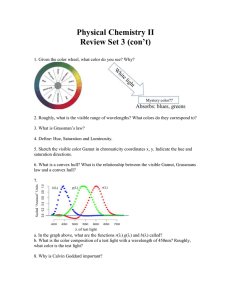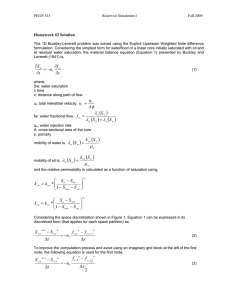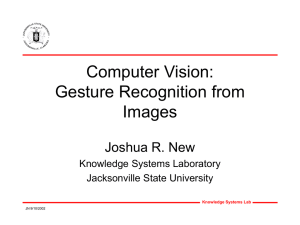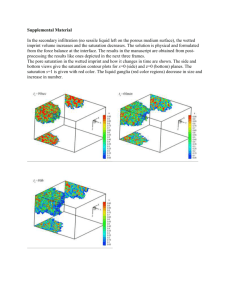Colour Image Enhancement for Ziehl-Neelsen Slide Images
advertisement
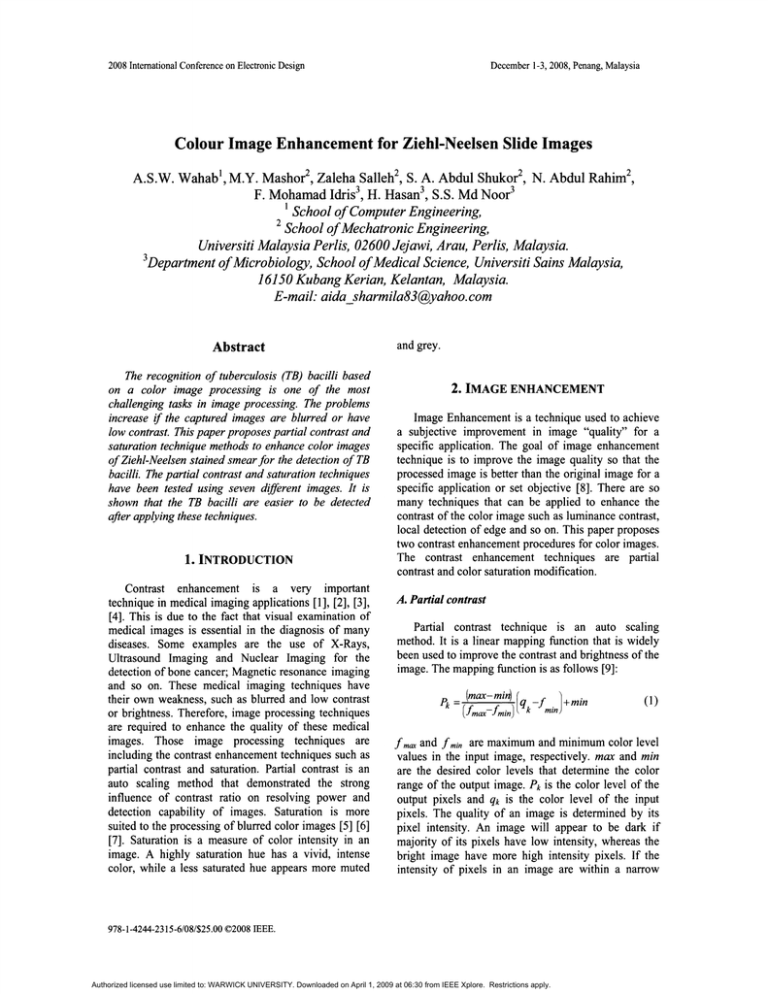
2008 International Conference on Electronic Design December 1-3, 2008, Penang, Malaysia Colour Image Enhancement for Ziehl-Neelsen Slide Images A.S.W. Wahabl,M.Y. Mashor2, Zaleha Salleh2, S. A. Abdul Shukor2, N. Abdul Rahim2, F. Mohamad Idris3, H. Hasan3, S.S. Md Noor3 School ofComputer Engineering, 2 School ofMechatronic Engineering, Universiti Malaysia Perlis, 02600 Jejawi, Arau, Perlis, Malaysia. 3Department ofMicrobiology, School ofMedical Science, Universiti Sains Malaysia, 16150 Kubang Kerian, Kelantan, Malaysia. E-mail: aida_sharmila83@yahoo.com 1 Abstract The recognition of tuberculosis (TB) bacilli based on a color image processing is one of the most challenging tasks in image processing. The problems increase if the captured images are blurred or have low contrast. This paper proposes partial contrast and saturation technique methods to enhance color images ofZiehl-Neelsen stained smear for the detection of TB bacilli. The partial contrast and saturation techniques have been tested using seven different images. It is shown that the TB bacilli are easier to be detected after applying these techniques. 1. INTRODUCTION Contrast enhancement is a very important technique in medical imaging applications [1], [2], [3], [4]. This is due to the fact that visual examination of medical images is essential in the diagnosis of many diseases. Some examples are the use of X-Rays, Ultrasound Imaging and Nuclear Imaging for the detection of bone cancer; Magnetic resonance imaging and so on. These medical imaging techniques have their own weakness, such as blurred and low contrast or brightness. Therefore, image processing techniques are required to enhance the quality of these medical images. Those image processing techniques are including the contrast enhancement techniques such as partial contrast and saturation. Partial contrast is an auto scaling method that demonstrated the strong influence of contrast ratio on resolving power and detection capability of images. Saturation is more suited to the processing of blurred color images [5] [6] [7]. Saturation is a measure of color intensity in an image. A highly saturation hue has a vivid, intense color, while a less saturated hue appears more muted and grey. 2. IMAGE ENHANCEMENT Image Enhancement is a technique used to achieve a subjective improvement in image "quality" for a specific application. The goal of image enhancement technique is to improve the image quality so that the processed image is better than the original image for a specific application or set objective [8]. There are so many techniques that can be applied to enhance the contrast of the color image such as luminance contrast, local detection of edge and so on. This paper proposes two contrast enhancement procedures for color images. The contrast enhancement techniques are partial contrast and color saturation modification. A. Partial contrast Partial contrast technique is an auto scaling method. It is a linear mapping function that is widely been used to improve the contrast and brightness of the image. The mapping function is as follows [9]: D £k (max-min) [q - f . J+mln . (fmax-fmin) k mm f (1) max and f min are maximum and minimum color level values in the input image, respectively. max and min are the desired color levels that determine the color range of the output image. Pk is the color level of the output pixels and qk is the color level of the input pixels. The quality of an image is determined by its pixel intensity. An image will appear to be dark if majority of its pixels have low intensity, whereas the bright image have more high intensity pixels. If the intensity of pixels in an image are within a narrow 978-1-4244-2315-6/08/$25.00 ©2008 IEEE. Authorized licensed use limited to: WARWICK UNIVERSITY. Downloaded on April 1, 2009 at 06:30 from IEEE Xplore. Restrictions apply. range, the image will has low contrast; whereas an image of good contrast will have wider range of image pixels intensity. Thus, partial contrast technique will determine the range of pixels' intensity and then map them into a wider range of intensity to enhance the raw image. Before the mapping process start, the system will find the range of where the majority of the input pixels converge for each color space. Since the input images are the RGB model, so it is necessary to find the range for the red, blue and green intensity. After that, the average will be calculated for these upper and lower color values of the range of three color space by using the following formula: maxTH =(maxRsd +maxBlue +maxGreen)/3 minTH = ( min Red +minBlue +minGreen) 13 be map to a wider range and brighter intensity; as a result the contrast level of the raw images is increased. As an example (refer to Figure I), let's assumed that the majority of the pixel for the input image have the lower and upper threshold values of 80 and 200, with the desired range of the color levels for the output image from 20 to 230. Then the original range of the input image will be stretched to the range from 20 to 230. The color levels below 80 will be compressed to the range of 0 to 20 and the color levels greater than 200 will experience compression to the range of 230 to 255. Lower threshold value RO (2) maxRed, maxBlue and maxGreen are the maximum color level of the range in each red, blue and green color pallettes, respectively. minRed, minBlue and minGreen are the minimum value of the converge range of each color pallette, respectively. maxTH and minTH are the average number of these maximum and minimum color levels for each color space. The maxTH and minTH will be used as the desired color ranges for all the three color palettes. The purpose of the three color palette to have the same threshold value is to avoid the color level to be place out side of a valid color level. After that, the mapping process will be started. The function in Equation 3 will be used for the pixels transformation, which is based on the concept of the linear mapping function in Equation I. Refer to Equation 3, minTH is the lower threshold value where the maxTH is the upper threshold value. NewrninTH and NewrnaxTH are the lower and upper new stretching values, respectively. in(x,y) is the color level for the input pixel (x,y) and the out(x,y) is the color level for the output pixel. The pixel within the range of minTH and maxTH will be stretched to the desire range of max to min, whereas the remaining pixels will experience compression. By this stretching and compressing process, the pixels of the image can o 20 in(x,y) max TH * New max TH 230 255 Figure 1. Partial contrast process B. Saturation According to the principle of color imaging theory, saturation or purity refers to the intensity of a specific hue. A highly saturated hue has a vivid and intense color, while a less saturated hue appears to be more grayish [10]. In imaging, color saturation is used to describe the intensity of color in the image. A saturated image has overly bright colors. A technique of colour saturation can increase the saturation of an underexposed image, and vise versa. In an RGB color space, saturation can be thought of as the standard deviation (J of the color coordinates R (red), G (green), and B (blue). Letting 11 to represent the brightness, defined as the mean of R, G, and B. in(x,y) * lVew u . '7''H nun 1, minTH (NeWmaXTH - NewminTH) (. ( ) f . ~] . out(x,y) = -'------------'* ,,111 X Y - nun) +nun [ max TH - min TH ' ---'--=-.:.... Upper threshold value ?OO if in(x,y»minTH ifminTH<in(x,y)<maxTH ifin(x,y)<maxTH Authorized licensed use limited to: WARWICK UNIVERSITY. Downloaded on April 1, 2009 at 06:30 from IEEE Xplore. Restrictions apply. (3) a= (R - Jl)2 + (G - Jl)2 + (B - Jl)2 (4) 3 The color saturation technique is based on the color information of the bacterium to extract it from sputum and other object. This technique specifies the range of red, green and blue intensity for the saturation [6]. The objects that lie outside the selection range will be rejected. So, it is important to determine the selection range because if this saturation cannot acquire the suitable value, it will extract pixels other than the interested object. Therefore, a study on the color information of the mycobacterium and sputum are made in order to get the most suitable value to be the selection range. For the color saturation process, the value of saturation index of 3.0 was found to suitable for all original images because the information of image can be displayed clearly. 3. RESULTS In this section, four original images as show in Figure 2, were used to test the performance of partial contrast method. These images have low contrast level and brightness. The range of lower and upper threshold values for original images in Figure 2 are 80 and 235, respectively. The desired range of the color levels for the output images are from 50 to 250. These values found to be suitable for all the input images and the results are as shown in Figure 2. These information shows that the original images are not bright enough and the contrast level are quite low. Therefore, the partial contrast has improved the contrast and brightness level. For the color saturation process, the value of saturation index of 3.0 was found be suitable for all original images and the results are as shown in Figure 3. A simple adjustment to the color saturation gives a much more vivid image. So this image processing technique may be used for under-stained slides without the need for re-staining, which will incur more cost and processing time. TB bacilli appear to be clearer after the images have been processed by partial contrast or color saturation techniques. 4. CONCLUSION The proposed methods have potential to be used for enhancing the Ziehl-Neelsen slide images. Partial contrast has been shown to be good for enhancing the contrast and brightness of the images. This is useful for low contrast, over exposed or under exposed images. It has been demonstrated that the technique is applicable for color images with proper selection of the upper and lower color levels as discussed in previous sections. Saturation technique was shown to be very useful to enhance the color of the low saturation color level images. This is particularly useful for under-stained slides where re-stain may be avoided. After applying both techniques, the TB bacilli will be easier to be detected. ACKNOWLEDGMENT This research was supported by University Malaysia Perlis Fund under grant 9005-00003 and MOSTI. REFERENCES [1] R. H. Sherrier, and G. A. Johnson, "Regionally adaptive histogram equalization of the chest", IEEE Tarns.Med.Imaging.6, pp. 1-7, 1987. [2] H. D. Cheng and H. Xu, "A novel fuzzy logic approach to contrast enhancement", Pattern Recognition.33, pp. 809-819 ,2000. [3] A.I Polese, G. Ramponi, and V.J. Mathews, "Image enhancement via adaptive unsharp masking", IEEE Trans.Image Processing. 9, pp. 505-510, Mar.2oo0. [4] T. Zong, H. Lin, and T. Kao, "Adaptive local contrast enhancement method for medical images displayed on a video monitor," Med. Eng. Phys., vol. 22, pp. 79-87 , 2000. [5] Y-I Ohta, T. Kanade & T. Sakai "Color segmentation for region segmentation", Computer Graphics and Image processing, 13, pp. 222-241 , 1980. [6] 1. Kender, "Saturation, hue and normalized color: calculation digitization effects, and use", Master's thesis, Dept ofCS. Camegie-Mellom university, 1976. [7] B.A. Tomas and R.N. Strickland, Color image enhancement using spatially adaptive saturation feedback, Proc. IEEE Inti. Conf. Image Process. 3, pp. 30-33,1997. [8] R. Gonzalez, and P. Wintz, "Digital Image Processing", Reading, MA: Addison-Wesley, 1987. [9] R.W. Weeks, Jr., "Fundamentals of Electronic Image Processing", Bellingham: SPIE Press, 1996. [10] H. Levkowitz and G. T. Herman, "A generalized lightness, hue and saturation color model", Graphical Models and Image Processing, 55(4), pp. 271-285, 1993. Authorized licensed use limited to: WARWICK UNIVERSITY. Downloaded on April 1, 2009 at 06:30 from IEEE Xplore. Restrictions apply. Figure 2. The result images after applying the partial contrast technique for original TB images. Resulted Images Original Images Smear 1 Smear 2 r P'~ 't. ...J Smear 3 ", .~.l Smear 4 Authorized licensed use limited to: WARWICK UNIVERSITY. Downloaded on April 1, 2009 at 06:30 from IEEE Xplore. Restrictions apply. Figure 2. The result images after applying the saturation technique for original TB images. Resulted Images Original Images r Smear 5 ..z.. .' Smear 6 Smear 7 Authorized licensed use limited to: WARWICK UNIVERSITY. Downloaded on April 1, 2009 at 06:30 from IEEE Xplore. Restrictions apply.


